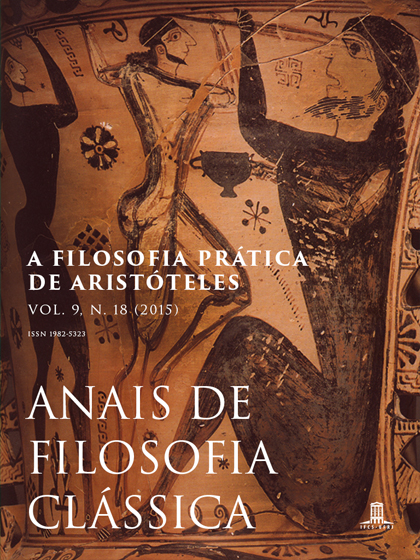Stabilité et instabilité : une tentative d'articulation entre éthique et poétique chez Sénèque
DOI:
https://doi.org/10.47661/afcl.v9i18.4843Keywords:
Seneca, Poetics, Ethics, Conscience, SecuritasAbstract
The contribution aims to show how the poetics of uncertainty and hesitation is, despite its paradoxical appearance, to be understood in continuity with the ethics of stability (securitas). One of the requirements of achieving happiness according to the ethics of stability in Seneca's philosophical prose is innoxia, the absence of harm and evil done to the others. When one commits crimes, the punishment is already in the act itself, in our conscience. And a conscience that knows its own crime will never have an inner stability. Therefore the evil acted and experienced by the protagonists of the senecan tragedies seems to determine a poetics of uncertainty, characterized by the presence of the doubt on a thematic and stylistic level. The poetic discourse of the tragedy appears therefore to be complementary to the ethical discourse of the philosophical prose and the tragedies are conceivable as a commentary of the philosophical work.
Downloads
References
ALBERTI A. The epicurean theory of law and justice. In: ______. Justice and Generosity: Studies in Hellenistic Social and Political Philosophy: Proceedings of the Sixth Symposium Hellenisticum. Cambridge: Cambridge University Press, 1995, pp. 161-190.
ALBINI U. La storia di Edipo in Seneca. Rivista di Filologia e di Istruzione Classica. Torino, 123, pp. 428-432, 1995.
ALLENDORF T. The poetic of uncertainty in Senecan drama. Materiali e discussioni per l'analisi dei testi classici. Pisa, 71, pp. 103-144, 2013.
ATKINS J. W. Euripides Orestes and the concept of conscience in Greek philosophy. Journal of the History of Ideas. Baltimore (Md.), 75, pp. 1--22, 2014.
BARBERIS G. Curas revolvit animus et repetit metus: osservazioni sulla paura dell'Edipo senecano. Paideia. Brescia, 49, pp. 3-7, 1994.
______. Una punizione al di là della vita e della morte: la poesia della colpa nell'Oedipus. Paideia. Brescia, 51, pp. 161-170, 1996.
CITTI F. Cura sui. Studi sul lessico filosofico di Seneca. Amsterdam: Hakkert, 2012.
______ ET AL. CEdipo classico e contemporaneo. Zürich-New York: Olms, 2012.
DINGEL J. Seneca und die Dichtung. Heidelberg: Carl-Winter Universitätverlag, 1974.
LEFEBVRE R. Représentation, lumière, conscience chez les stoïciennes.Revue des Études Grecques. Paris, 120, pp. 469-483, 1997.
MASTRONADE D. J. Seneca's Oedipus. The drama in the word. Transactions of the American Philological Association. Baltimore (Md.),101, pp. 291-315, 1970.
MAZZOLI G. Seneca e la poesia. Milano: Pubblicazioni della Facoltà di Lettere e Filosofia dell'Università di Pavia. Istituto di Letteratura Latina, Ceschina, 1970.
______. Il gioco delle parti: un tema gnomico senecano e le sue ridondanze metateatrali. Quaderni di cultura e di tradizione classica. Palermo, VIII, pp. 87-100, 1990.
______. Seneca e la poesia. In:______. Sénèque et la prose latine. Neuf exposés suivis de discussions (Vandoeuvres-Genève, 14-18 aout 1991). Genève: Fondation Hardt, 1991, pp. 177-219.
______. Demifisticazione del mito e mitizzazione della storia nello stoicismo di Seneca. In:______. Filosofia, storia, immaginario mitologico. Alessandria: Edizioni dell'Orso, 1997, pp. 149-153.
______. Il tragico in Seneca. Lexis. Amsterdam, 15, pp. 79-91, 1997.
______. Error e culpa nelle tragedie di Seneca. Aevum. Milano, 10, pp. 321-331, 2010.
SCHIESARO A. Seneca's Thyestes and the morality of tragic furor. In:______. Reflections of Nero: culture, history, and representation. Chapel Hill-London: The University of North Carolina Press, 1994, pp. 196-210.
______. Passion, reason and knowledge in Seneca's tragedies. In: ______. The passions in Roman thought and literature. Cambridge: Cambridge University Press, 1997, pp. 89-111.
______. The Passions in Play. Thyestes and the Dynamics of Senecan Drama, Cambridge: Cambridge University Press, 2003.
SCHOFIELD M. The stoic approaches to justice.In: ______. Justice and Generosity: Studies in Hellenistic Social and Political Philosophy: Proceedings of the Sixth Symposium Hellenisticum. Cambridge: Cambridge University Press, 1995, pp. 191-212.
SORABJI R. Moral Conscience trough the ages. Oxford: Oxford University Press, 2014.
STROHM P. Conscience: A Very Short Introduction. Oxford: Oxford University Press, 2011.
C. TORRE. «Alia temptanda est via»: alcune riflessioni sui recenti sviluppi della questione dei «due» Seneca (morale e tragico). Acme. Milano, 60/1, pp. 37-84, 2007.
______. Seneca tragico vs. Seneca filosofo. Nuovi approcci a una vecchia querelle.In:______. La filosofia a teatro. Milano: Cisalpino 2010, pp. 41-61.


